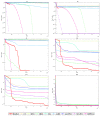An Enhanced Hunger Games Search Optimization with Application to Constrained Engineering Optimization Problems
- PMID: 37754192
- PMCID: PMC10526405
- DOI: 10.3390/biomimetics8050441
An Enhanced Hunger Games Search Optimization with Application to Constrained Engineering Optimization Problems
Abstract
The Hunger Games Search (HGS) is an innovative optimizer that operates without relying on gradients and utilizes a population-based approach. It draws inspiration from the collaborative foraging activities observed in social animals in their natural habitats. However, despite its notable strengths, HGS is subject to limitations, including inadequate diversity, premature convergence, and susceptibility to local optima. To overcome these challenges, this study introduces two adjusted strategies to enhance the original HGS algorithm. The first adaptive strategy combines the Logarithmic Spiral (LS) technique with Opposition-based Learning (OBL), resulting in the LS-OBL approach. This strategy plays a pivotal role in reducing the search space and maintaining population diversity within HGS, effectively augmenting the algorithm's exploration capabilities. The second adaptive strategy, the dynamic Rosenbrock Method (RM), contributes to HGS by adjusting the search direction and step size. This adjustment enables HGS to escape from suboptimal solutions and enhances its convergence accuracy. Combined, these two strategies form the improved algorithm proposed in this study, referred to as RLHGS. To assess the efficacy of the introduced strategies, specific experiments are designed to evaluate the impact of LS-OBL and RM on enhancing HGS performance. The experimental results unequivocally demonstrate that integrating these two strategies significantly enhances the capabilities of HGS. Furthermore, RLHGS is compared against eight state-of-the-art algorithms using 23 well-established benchmark functions and the CEC2020 test suite. The experimental results consistently indicate that RLHGS outperforms the other algorithms, securing the top rank in both test suites. This compelling evidence substantiates the superior functionality and performance of RLHGS compared to its counterparts. Moreover, RLHGS is applied to address four constrained real-world engineering optimization problems. The final results underscore the effectiveness of RLHGS in tackling such problems, further supporting its value as an efficient optimization method.
Keywords: Hunger Games Search; Rosenbrock Method; benchmark; engineering optimization problems; logarithmic spiral; swarm intelligence.
Conflict of interest statement
The authors declare no conflict of interest.
Figures













Similar articles
-
Multiple strategies improved spider wasp optimization for engineering optimization problem solving.Sci Rep. 2024 Nov 23;14(1):29048. doi: 10.1038/s41598-024-78589-8. Sci Rep. 2024. PMID: 39580529 Free PMC article.
-
Optimizing VGG16 deep learning model with enhanced hunger games search for logo classification.Sci Rep. 2024 Dec 30;14(1):31759. doi: 10.1038/s41598-024-82022-5. Sci Rep. 2024. PMID: 39738231 Free PMC article.
-
Salp Navigation and Competitive based Parrot Optimizer (SNCPO) for efficient extreme learning machine training and global numerical optimization.Sci Rep. 2025 Apr 21;15(1):13704. doi: 10.1038/s41598-025-97661-5. Sci Rep. 2025. PMID: 40258903 Free PMC article.
-
Modified Sparrow Search Algorithm by Incorporating Multi-Strategy for Solving Mathematical Optimization Problems.Biomimetics (Basel). 2025 May 8;10(5):299. doi: 10.3390/biomimetics10050299. Biomimetics (Basel). 2025. PMID: 40422129 Free PMC article.
-
Training a Feedforward Neural Network Using Hybrid Gravitational Search Algorithm with Dynamic Multiswarm Particle Swarm Optimization.Biomed Res Int. 2022 May 30;2022:2636515. doi: 10.1155/2022/2636515. eCollection 2022. Biomed Res Int. 2022. Retraction in: Biomed Res Int. 2024 Mar 20;2024:9783980. doi: 10.1155/2024/9783980. PMID: 35707376 Free PMC article. Retracted. Review.
Cited by
-
Enhancement of Classifier Performance Using Swarm Intelligence in Detection of Diabetes from Pancreatic Microarray Gene Data.Biomimetics (Basel). 2023 Oct 22;8(6):503. doi: 10.3390/biomimetics8060503. Biomimetics (Basel). 2023. PMID: 37887634 Free PMC article.
References
-
- Lu Z., Cheng R., Jin Y., Tan K.C., Deb K. Neural Architecture Search as Multiobjective Optimization Benchmarks: Problem Formulation and Performance Assessment. IEEE Trans. Evol. Comput. 2022:1. doi: 10.1109/TEVC.2022.3233364. - DOI
-
- Wang Z., Zhao D., Guan Y. Flexible-constrained time-variant hybrid reliability-based design optimization. Struct. Multidiscip. Optim. 2023;66:89. doi: 10.1007/s00158-023-03550-8. - DOI
-
- Bai X., Huang M., Xu M., Liu J. Reconfiguration Optimization of Relative Motion Between Elliptical Orbits Using Lyapunov-Floquet Transformation. IEEE Trans. Aerosp. Electron. Syst. 2022;59:923–936. doi: 10.1109/TAES.2022.3193089. - DOI
-
- Lu C., Zheng J., Yin L., Wang R. An improved iterated greedy algorithm for the distributed hybrid flowshop scheduling problem. Eng. Optim. 2023:1–19. doi: 10.1080/0305215X.2023.2198768. - DOI
-
- Zhang K., Wang Z., Chen G., Zhang L., Yang Y., Yao C., Wang J., Yao J. Training effective deep reinforcement learning agents for real-time life-cycle production optimization. J. Pet. Sci. Eng. 2022;208:109766. doi: 10.1016/j.petrol.2021.109766. - DOI
Grants and funding
LinkOut - more resources
Full Text Sources

